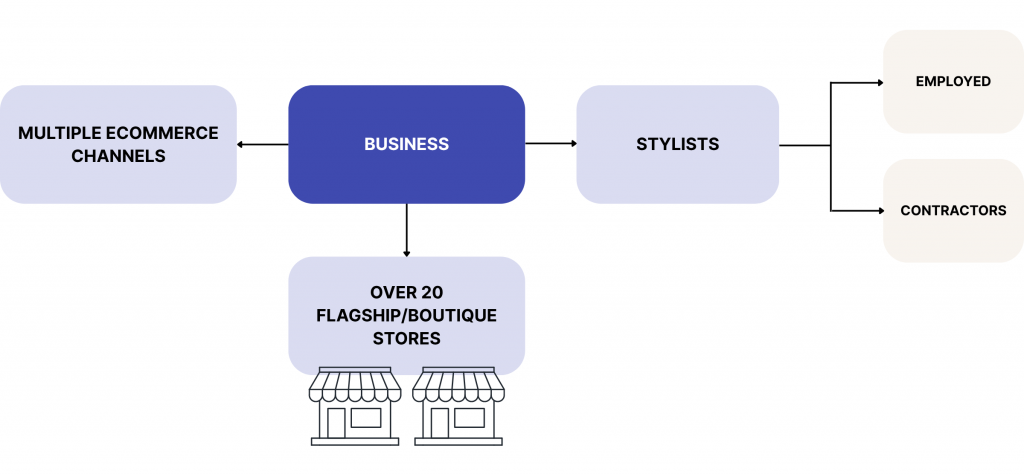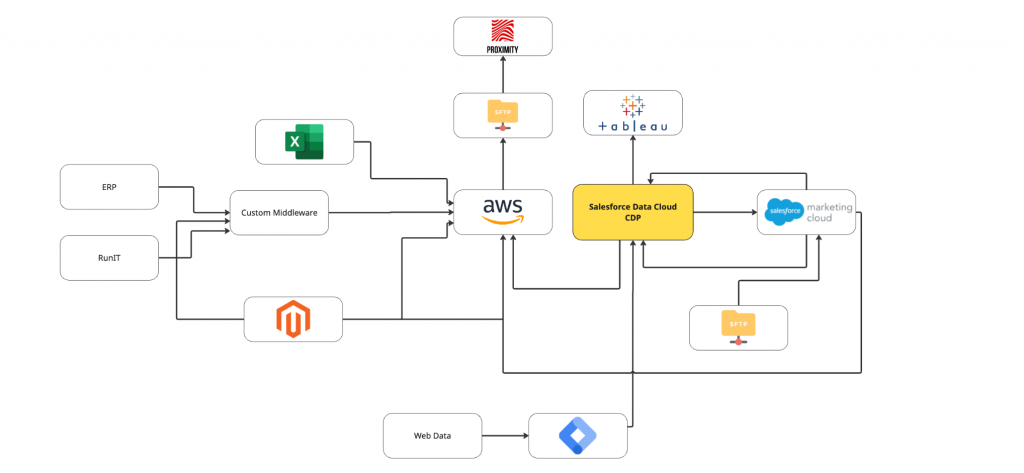A luxury fashion house in New York partnered with scandiweb to rebuild its customer data infrastructure and improve how it personalized experiences across channels. With boutiques, outlet locations, international stores, and a high-touch clienteling model, the brand needed a system that could unify fragmented data, support calculated traits, and power smarter segmentation.
Across the 5 years of using a customer data platform (CDP), they’ve doubled revenue, automated hundreds of hours of reporting work, and now drive over 40% of online revenue through targeted email and SMS, reducing reliance on paid media, strengthening loyalty from high-value customers, and saving money while gaining complete control over their in-store and digital customer data.
About
Our client is a New York City-based fashion house that specializes in women’s apparel, footwear, and accessories, offering a range of modern and sophisticated designs. They sell in physical boutiques and online with an eCommerce store powered by Magento. In the boutiques, stylists and store clerks enhance the shopping experience by offering personalized recommendations based on customer preferences.

Their operations rely heavily on a CDP to support personalization and data-driven decision-making across channels.
Also read:
Webinar Recap: How to Increase Your eCommerce Revenue 2-3x with CDPs
Challenges
The brand’s data ecosystem was highly complex. With operations spanning flagship boutiques, outlet and international stores, stylists providing 1:1 guidance, and an eCommerce store powered by Magento, customer interactions were scattered across many systems. Each customer could be represented by multiple identifiers – email, phone number, loyalty account, purchase history, and in-store interactions, making it difficult to form a unified profile.
At the start of our collaboration, the client was already using an advanced customer data platform to support its personalization and marketing efforts. Over time, however, specific challenges, such as limited flexibility in managing identity resolution rules and increasing demands on reporting, led them to explore new solutions. With a focus on scalability, internal control, and deeper integration across its systems, we chose to migrate to Salesforce Data Cloud.
- Moving to a new platform without disrupting existing workflows
A major concern during the migration was ensuring that existing workflows remained uninterrupted. The brand faced a strict deadline before their Acquia contract expired, which would have required committing to another year of service. Within this tight timeframe, we had to complete the migration to Salesforce Data Cloud, ensure all systems were integrated, and thoroughly test that data processes continued running smoothly without disruptions. - Reporting inefficiencies and missed revenue opportunities
The fashion brand needed deeper insights into customer purchasing behavior, but limited reporting tools required extensive manual effort to compile and analyze data. Since reports could not be generated automatically, teams had to manually export raw data, transfer files via SFTP (Secure File Transfer Protocol), and piece together information using pivot tables and VLOOKUP functions. This time-consuming work diverted resources away from tasks with higher ROI, like more time spent identifying upselling and cross-selling opportunities. - Identity resolution limitations
While the team had visibility into why customer profiles merged or didn’t merge, they could not modify the matching logic without support from Acquia. It was difficult to react quickly to data discrepancies or evolve identity resolution rules as business needs changed. - Limitations in digital marketing insights and customer acquisition tracking
Acquia lacked the ability to link website visits, product interactions, and purchase intent to individual customer profiles, leaving marketing teams without clear visibility into customer journeys. Additionally, the platform did not support direct integration with advertising networks, meaning customer data could not be synced with Google Ads or Meta. Without this connection, the company could not run targeted ad campaigns or measure how ads influenced purchases. The transition to Salesforce needed to bridge this gap by integrating web event tracking and aligning customer interactions with marketing performance. - Scalability concerns and long-term growth
The company needed a system that could evolve with their customer data strategies without incurring high implementation costs. Already using Salesforce Marketing Cloud, they benefited from good data exchange within the Salesforce ecosystem, making Salesforce Data Cloud a future-proof choice for expanding capabilities and maintaining operational efficiency over time.
Approach
scandiweb implemented a flexible, scalable solution to migrate to Salesforce Data Cloud, enabling improved customer segmentation and reduced reliance on external services.
Transitioning from Acquia to Salesforce Data Cloud
The previous system was deeply integrated into the brand’s data workflows, making it critical to preserve existing functionality during the migration. scandiweb implemented Salesforce Data Cloud to give the internal team greater control over data processes and simplify future changes.
A key part of the migration involved integrating Salesforce Data Cloud with their existing technology stack, including Magento, in-store customer relationship tools, and external data sources.
Data validation and integrity checks were utilized throughout the migration to prevent discrepancies and ensure a clean dataset. We developed customized automation rules, which helped map Acquia’s existing data structures into Salesforce without data loss or corruption.
The transition process included initial user training to help internal teams get up to speed with the new system. With the most technical onboarding still underway, the brand is building toward full in-house autonomy. The migration to Salesforce Data Cloud laid the groundwork for a scalable and future-ready customer data infrastructure.
New data infrastructure with AWS
As the project progressed, we encountered limitations in data ingestion and transformation capabilities within the initial setup. To address it, we explored external cloud solutions and expanded the existing AWS environment to support more flexible and scalable data operations.

The following AWS services were integrated into the new setup:
- AWS S3
- Used to store most ingested input data sources
- Also serves as the storage for processed files ready for ingestion into the Salesforce Data Cloud
- AWS Glue
- Handles data transformations such as blacklisting, standardization, and API-based tasks
- Combined visual ETL configuration for simpler workflows with custom code via the Script Editor for more complex processes
- AWS Glue DataBrew
- Enables visual data profiling and initial data exploration to identify key issues and edge cases
- Also used to validate outputs during pipeline quality assurance
- AWS Lambda
- Used for real-time processing jobs triggered by specific events
- AWS Redshift Serverless
- Implemented as a data warehouse to support structured data access and analysis without infrastructure management overhead.
Identity resolution system update
Identity resolution is the process of matching and unifying customer data across multiple touchpoints to create a single, accurate customer profile. Each individual is recognized consistently across online, in-store, and marketing interactions. Without a proper identity resolution system, businesses face issues like duplicate records and a fragmented view of their audience.
To support unified customer profiles, scandiweb configured Salesforce Data Cloud’s identity resolution framework to fit the existing data logic and structure. Our setup included tools for testing and validating match rules in a controlled environment, ensuring confidence in profile merges before any changes were applied. The migration process also included knowledge transfer and onboarding for internal teams to take ownership of the identity resolution logic moving forward.
Calculated traits and segmentation
With unified customer profiles in Salesforce Data Cloud, the team gained the ability to work with calculated traits – derived attributes that go beyond standard fields from source systems. They gave a more detailed view of customer behavior and preferences.
Examples of calculated traits
- Order metrics: lifetime order count, time since first and most recent purchase, purchase frequency by period (last 12 months, 13–24 months, 24+ months)
- Revenue patterns: lifetime revenue, decile rankings, trend segments
- Engagement: email and SMS sends, clicks, opens, CTR by timeframe
- Web activity: total sessions, last session date
- Preferences: sizes, colours, product types, styles, channels, preferred stylist or store.
Segmentation strategies based on enriched customer profiles
- Full-price vs off-price buyers
- Lifecycle stages (new, inactive, lapsed, reactivated, unidentified)
- Revenue trend groups
- Location-based segments for in-store events
- Product-based segments for tailored communications.
Automated analytics with Tableau
With the implementation of Tableau as the primary business intelligence tool, we created an automated analytics framework. Tableau’s integration with Salesforce Data Cloud enabled the company to automate reporting processes and centralize performance tracking across teams.
Enriching customer segmentation with external data
Customer segmentation plays a key role in our client’s personalization efforts. The previous platform made integrating new data sources difficult, limiting the segmentation depth. With the new system, adding third-party data became significantly easier, enabling more refined and flexible audience segmentation.
With Salesforce Data Cloud, we ensured they gained the ability to ingest and unify external data sources to support more advanced customer segmentation. For example, Census Data enriched segmentation efforts by adding socioeconomic indicators.
Results
1. 85% of revenue generated by re-engaging existing customers
With better visibility into customer history and preferences, the brand focused more on retention and lifecycle-based engagement. Personalized campaigns, proactive churn prevention, and curated in-store experiences helped make the most of their existing customer base.
2. Highly personalized in-store customer experience
The brand had existing customer profile visibility in their clienteling tool, which stylists use to enhance the in-store experience. scandiweb supported migrating this data to Salesforce Data Cloud and preserved the export process to Proximity. We built a new dashboard in Tableau, offering greater flexibility to access and customize customer insights. Unlike frontend changes in the previous clienteling tool, Tableau dashboards could be quickly updated internally to expand available data to stylists without relying on external development.
scandiweb’s implementation of Salesforce Data Cloud enabled them to deliver an even more personalized in-store experience. Staff can access detailed profiles before appointments, including transaction history and preferred product categories, to tailor recommendations more precisely, create a curated shopping experience, and anticipate customer needs.
3. Effective email and SMS marketing communication
Email and personalized SMS marketing contribute over 40% of online sales. By contrast, brands without a CDP often generate just 1–3% of revenue from these channels.
The brand leveraged our consolidated customer data to implement more precise email and SMS marketing segmentation. To engage customers, personalized offers and targeted messaging were sent based on purchase history, browsing behavior, and engagement patterns, delivering promotions aligned with their shopping habits and preferences.
4. Enhanced identity resolution
Salesforce Data Cloud allows them to test, compare, and deploy identity resolution rules. Instead of relying on predefined, unchangeable rules, they can now adjust identity resolution settings based on their specific needs, giving them greater control in managing customer data.
5. Targeted advertising spend and ROAS improvements
With customer data more accessible and organized in Salesforce Data Cloud, we improved how audience segments were activated within Google Ads and Meta Ads. Building on its existing personalization efforts, they can deliver more personalized ads to existing customers and high-intent prospects, potentially reducing wasted ad spend and increasing ROAS. Additionally, third-party data enrichment enhanced customer lifetime value modeling, helping the team better prioritize high-value audiences.
6. Advanced business reporting and BI solutions
Our integration of Salesforce Data Cloud and Tableau enabled a centralized and automated business intelligence system. Teams can now track KPIs automatically, measure the effectiveness of customer segments, and analyze user journeys.
Interactive dashboards allow deeper customer data exploration, with Tableau’s drill-down capabilities for reviewing behavior by segment, transaction history, or web engagement. This has reduced reporting time and improved the speed and accuracy of business decision-making. With access to more reliable data, our client can plan long-term strategies based on customer behavior.
Looking to transform your customer data management? scandiweb can help you leverage Salesforce Data Cloud or any suitable platform to streamline reporting, optimize marketing, and enhance customer engagement. Get in touch today to learn how we can help!


Share on: